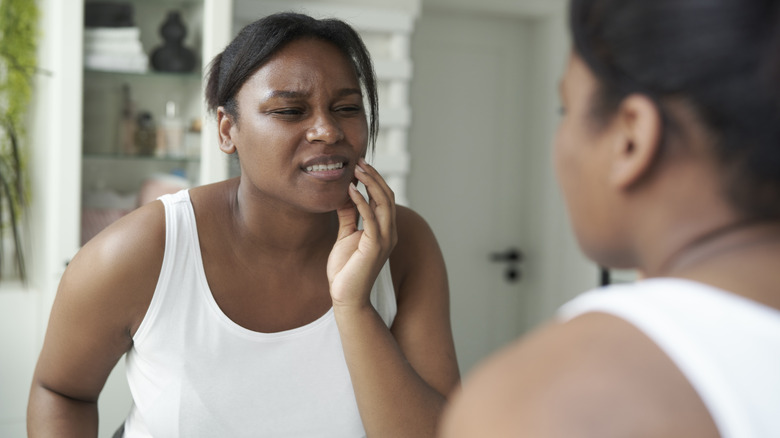Ignoring This Dental Habit Can Make You Look Older
Smoking, a lack of sleep, and spending too much time in the sun aren't the only habits that can make us look older than we might like. The health of our teeth and gums can also work either for or against us when it comes to maintaining our youth. Poor dental hygiene can lead to yellow staining or even tooth loss, which can impact the shape of the jawbone and subsequently cause the muscles of our face to droop (via Daniel Castro D.D.S. Implant, Cosmetic and General Dentistry). However, even if you're regularly brushing, flossing, and rinsing with mouthwash, if you're a habitual teeth-grinder, ignoring this dental habit can potentially have aesthetic consequences.
Medically referred to as bruxism, the continuous teeth grinding and jaw clenching that characterizes the condition reportedly affects up to 31% of the population, according to updated 2024 research published in StatPearls. There are two categories of the condition: wake bruxism and sleep bruxism. Impacting as many as 15% to 40% of children and approximately 8% to 10% of adults, sleep bruxism has been tied to various health conditions, including obstructive sleep apnea (OSA), restless leg syndrome, and sleep-related gastroesophageal reflux disease (GERD). Whether you're grinding your teeth as you dream or tightening your jaw in the midst of a stressful day, bruxism can lead to adverse outcomes, including structural changes to the face that can age us more quickly, according to 2017 research published in The Journal of Clinical and Aesthetic Dermatology.
How bruxism may age the lower half of the face faster
Influenced by a number of different factors, such as structural abnormalities, family history, lifestyle habits, and certain health conditions, including some mental health disorders, bruxism can have damaging effects on the surrounding jaw muscles and joints. As outlined in the 2017 research paper, the main muscles that get worked when we're unconsciously grinding our teeth are the masseters and temporalis muscles. These are two of four muscle groups that make up what's known as the primary mastication muscles, according to 2023 updated research published in StatPearls. It's these muscles that are responsible for jaw movement to facilitate the chewing and grinding of food.
In cases of bruxism, the masseters and temporalis muscles become progressively enlarged, which may give the face a more masculine, square shape. People with bruxism may also find that the lower half of their face looks older starting at a younger age. Signs may include sagging of the nasal tip, lengthening of the upper lip, downturned mouth corners, jowl formation, and loss of cupid's bow — or the small dip in the middle of the upper lip that creates two peaks on either side, giving the shape of the upper lip a bow-like appearance. Naperville Dental Specialists further add that ongoing teeth grinding can gradually wear away at protective enamel, shortening the length of our teeth. In more severe cases involving tooth loss or jawbone loss, the face may sag from a lack of bone support.
Treatments for bruxism and related facial aging
In addition to potentially sending the skin and muscles of our face running south, bruxism may also lead to headaches, ocular pain, hearing impairment, trouble swallowing, neck stiffness, lock jaw, jaw popping, and more (via The Journal of Clinical and Aesthetic Dermatology). Recommended at-home treatment methods may include icing sore facial muscles, prioritizing sleep and adequate hydration, facial massage, stress-reduction techniques (which may include supplementation), steering clear of chewing gum, and implementation of jaw-relaxation exercises specifically for bruxism. Wearing a nighttime mouth guard may also be suggested.
Botox injections into the jaw muscles have also been used to alleviate pain, fatigue, and muscle spasming associated with bruxism. This method may be used in combination with additional aesthetic facial treatments, including fillers, lasers, and light therapies to treat signs of aging. Naperville Dental Specialists add that if these teeth-grinding-related facial changes are due to enamel erosion, dental veneers or cosmetic dental crowns can help restore one's youthful appearance. Alternatively, malocclusion (often caused by teeth overcrowding) can cause one's upper and lower jaw to be out of alignment. This increases the risk of bruxism, but teeth-straightening treatments can help eliminate grinding problems. If bruxism is related to a temporomandibular disorder (TMD), talk to your dentist about treatment options. Finally, if your face is beginning to age from bone loss due to bruxism, dental implants can help correct the problem.



